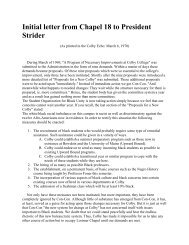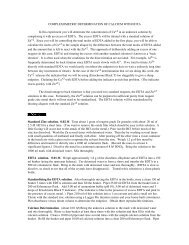Varian Zeeman Effect
Varian Zeeman Effect
Varian Zeeman Effect
Create successful ePaper yourself
Turn your PDF publications into a flip-book with our unique Google optimized e-Paper software.
Achieving accurate <strong>Zeeman</strong> background correction<br />
The <strong>Zeeman</strong> <strong>Effect</strong><br />
The <strong>Zeeman</strong> effect is the splitting and<br />
polarization of atomic spectral lines in<br />
the presence of a magnetic field.<br />
Molecular species and particulates that<br />
can cause background absorption remain<br />
relatively unaffected by the magnetic field.<br />
The <strong>Zeeman</strong> technique uses a magnetic<br />
field to achieve accurate background<br />
correction. With the magnet off, the total<br />
absorbance is measured. With the magnetic<br />
field applied, splitting of the spectral<br />
profile occurs, and only the background<br />
is measured. The atomic absorbance<br />
signal is determined by subtracting<br />
the background absorbance (magnet on)<br />
from the total absorbance (magnet off).<br />
The <strong>Varian</strong> solution<br />
<strong>Zeeman</strong> background correction is a<br />
powerful tool, but requires correct design to<br />
deliver accurate answers. The SpectrAA<br />
<strong>Zeeman</strong> features the sensitive transverse AC<br />
modulated <strong>Zeeman</strong> configuration, which has<br />
the field applied across the atomizer.<br />
This avoids the sensitivity losses observed<br />
with a DC (permanent) magnet and<br />
maximizes light throughput compared with<br />
longitudinal designs where end caps restrict<br />
the light passing through the pole pieces<br />
of the magnet. <strong>Varian</strong>’s patented magneticfield<br />
waveform provides a delay time of<br />
less than 5 ms between measurements and<br />
collects 100/120 data points (50/60 Hz)<br />
every second.<br />
Polynomial interpolation<br />
For accurate correction the instrument<br />
must determine the true background at the<br />
time the total signal was measured.<br />
Some instruments use simple linear<br />
interpolation of the background, which can<br />
result in erroneous calculations of the<br />
background signal if this signal is changing<br />
rapidly (a common occurrence with furnace<br />
analyses). SpectrAA <strong>Zeeman</strong> uses threepoint<br />
polynomial interpolation to accurately<br />
track the actual shape of the peak and<br />
correctly calculate the background signal at<br />
the time the total signal was measured.<br />
Background to<br />
be calculated at<br />
this ‘magnet off’<br />
measurement<br />
Background to<br />
be calculated at<br />
this ‘magnet off’<br />
measurement<br />
λ<br />
Magnet Off<br />
λ<br />
Magnet On<br />
Calculated<br />
signal<br />
inferior<br />
Background<br />
Molecular<br />
Absorption<br />
Total Absorbance<br />
Measured<br />
HC Lamp<br />
Emission Profile<br />
Background<br />
Molecular<br />
Absorption<br />
π component<br />
(parallel polarized)<br />
rejected by polarizer<br />
HC Lamp<br />
Emission Profile<br />
Total<br />
absorbance<br />
signal<br />
Magnet on (Background abs)<br />
Magnet off (Total abs)<br />
Linear Interpolation Procedure<br />
Polynomial Interpolation Procedure<br />
Total<br />
absorbance<br />
signal<br />
Magnet On (Background abs)<br />
Magnet Off (Total abs)<br />
The principle of<br />
the Transverse (AC)<br />
<strong>Zeeman</strong> technique<br />
Magnet Off<br />
The total absorbance<br />
is measured.<br />
Magnet On<br />
<strong>Zeeman</strong> splitting of<br />
the atomic absorption<br />
profile occurs and the<br />
polarizer excludes the<br />
central π component.<br />
This allows only<br />
background absorbance<br />
to be measured at<br />
the exact analytical<br />
wavelength.<br />
Linear interpolation<br />
between consecutive<br />
background data points<br />
incorrectly calculates<br />
the background.<br />
Erroneous results with<br />
complex matrices are<br />
often observed.<br />
The SpectrAA <strong>Zeeman</strong><br />
three-point polynomial<br />
interpolation accurately<br />
tracks the background<br />
signal, resulting in<br />
11 times improvement<br />
in correction accuracy.<br />
5
















